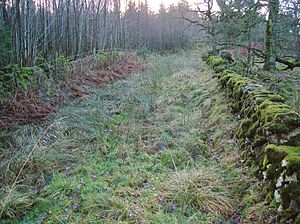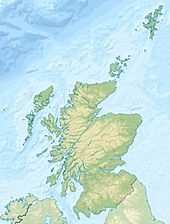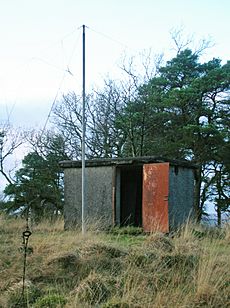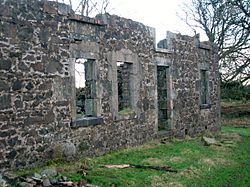Lands of Brownmuir facts for kids
Quick facts for kids Lands of Brownmuir |
|
|---|---|
| Beith, North Ayrshire, Scotland | |

Brownmuir Hill plantation and the Rakerfield drove road.
|
|
| Coordinates | 55°46′11″N 4°35′53″W / 55.769818°N 4.597952°W |
| Type | Laird's dwelling |
| Site information | |
| Owner | Private |
| Controlled by | Hamilton |
| Open to the public |
No |
| Condition | Now a farm |
| Site history | |
| Built | 18th century |
| Built by | Hamilton family |
| Materials | Stone |
The Lands of Brownmuir are an area in Scotland, near the town of Beith. This place has also been called Brown Muir or Brimmer in the past. It sits on the border between East Renfrewshire and North Ayrshire.
The settlements of Brownmuir and Rakerfield were once part of a larger property called the Brownmuir Estate. Brownmuir Hill, also known as Brimmer Hill, is a noticeable hill in the area. It offers views of the surrounding land, with other hills like Lochlands Hill and Cuff Hill nearby.
Contents
Exploring Brownmuir's History
The lands of Brownmuir were part of a special old district called the Regality of Kilwinning. This area was managed by the Bailiary of Cunninghame. To the west, Brownmuir bordered another old estate called Threepwood. Old maps from the 1700s don't show a large, fancy house for a laird (a Scottish landowner) here.
Brownmuir Farm and Surroundings
The name 'Brownmuir' likely comes from 'brown' and 'moor', which describes the land well. Today, Brownmuir Farm is located on a small road. This road connects Threepwood Road with Boydstone and Knowes Roads.
A special old road, called a drove road, once passed near Brownmuir Farm. This road went past Rakerfield Farm and joined another road near Newmills. Drovers' roads were used to move cattle and sheep to market.
In 1856, there was a lint mill on the Muir Burn near Brownmuir Farm. A lint mill was used to process flax, a plant used to make linen fabric. This mill had a wooden footbridge and two dams on the water. It was connected to Boydston Road by a short lane. This mill was located upstream from the Mill of Beith.
The remains of an old, abandoned farm called Langbank Farm can be found north of Brownmuir Hill. It is near where the old drove road met the Newmills to Threepwood road.
Brownmuir Hill's Features
Brownmuir or Brimmer Hill Plantation is a wooded area. It has trees like oak, rowan, Scots Pine, birch, and beech. The ground here is very wet and humid. Because of this, you can find many Sphagnum moss hummocks. These are soft, spongy mounds of moss that can rise up to a metre (about three feet) from the ground.
There was once a quarry on Brownmuir Hill where 'whinstone' was dug out. There was also a gravel pit. Several well-made cart tracks crossed the hill. At the very top of the hill, you can still see the remains of a radio shack and an aerial. This fenced-off area once had electricity.
The road that goes around the southern side of Brownmuir Hill (as seen in the photograph) looks wide enough to have been a drove road. People put a lot of effort into building strong stone walls along this road. These walls helped keep the animals on the road. This road might also have been used by pack animals like mules. It was likely built before wheeled carts became common on farms in the late 1700s. At that time, farmers often used large sledges to move heavy things.
Rakerfield's Story
In 1615, a merchant named William Montgomerie lived at Rakerfield. Rakerfield was located just off the old drove road. This road was a direct route from Beith to Howwood.
Rakerfield Farm was a two-storey building with a unique design. It had nicely carved stone around its windows and doors. It was once used as a hunting lodge and a home for a gamekeeper. A couple named Mr. and Mrs. Blair lived there when the Kirkleegreen Reservoir was being built. After they passed away, Ayrshire County Council bought the property and removed its roof.
The word 'Raker' in Scot's language means a traveller. This might connect to the old drove road that ran right past the property.
Who Owned Brownmuir?
Over the centuries, different families owned the Lands of Brownmuir.
The Hamilton Family
The Hamilton family of Brownmuir were important landowners. They were likely related to the Hamiltons of Wishaw. The first recorded laird from this family was Hugh Hamilton around 1611. Another Hamilton owner, William, is mentioned in records from 1615. This William Hamilton was also involved with lands in Auchinbothie-Blair.
In the 1600s, William Hamilton of Brownmuir was an elder at Beith Kirk (church). He had two daughters, Jean and Ursula. Jean (born 1662) married Robert Hamilton of Wishaw. Her family later inherited the title of Lord Belhaven. Ursula married James Cochrane around 1691.
The Crawfurd Family
In 1796, William, the seventh Lord Belhaven, sold the lands and mills of Brownmuir. He sold them to Hugh Crawfurd, who was a writer (a type of lawyer) in Greenock. Hugh Crawfurd married twice. His son James, from his second marriage, inherited the lands. James then sold them in 1829.
The Pratts and Others
John Pratt of Glentarkie in Fife bought the lands from Lord Belhaven. He became the sole owner. John was married to Isabella Crawfurd, who was Hugh Crawfurd's third daughter. After John and Isabella passed away, the property was jointly owned by Maria Eliza Stevenson and Margaret Stevenson. A Stevenson family also lived at Townend of Threepwood at one time.
Water Mills of Brownmuir
Several water mills were connected to the Lands of Brownmuir. These included the Mill of Beith. There was also likely a lint mill on the Muir Burn, near Brownmuir Farm. This mill was used for processing flax, and it had a pond nearby for 'retting' (a process to prepare flax fibres). The name of this lint mill is not known today.
Another mill existed at Boydston, across from the Mill of Beith. There were also bleach works at Threepwood and Sunnyside of Threepwood. These were used for bleaching linen fabric made from the processed flax.
Records from 1677 show an agreement involving William Hamilton of Brownmuir. He owned the corn mill at Mill of Beith. The agreement was with the people who were required to bring their grain to his mill for grinding. This was part of an old system called Thirlage.
The agreement explained how much meal the miller could take as payment for his work. It said the miller could take two "cogfulls" (small measures) of meal from each peck (a larger measure) of grain. This payment covered all fees and customs that were usually paid at the mill. The agreement also specified how the meal should be measured.
When William Hamilton, the seventh Lord Belhaven, sold the Lands of Brownmuir in 1796, the sale included not just one mill, but "mills" (plural). This suggests there were several mills associated with the estate at that time.





